Posted by Brian on April 11, 2015 · Leave a Comment
ATLANTA (7/2014)—Some homes in Carbon, Luzerne, and Schuylkill counties of Pennsylvania have elevated levels of radon gas in indoor air and radium in soils, according to a health consultation released today by the Agency for Toxic Substances and Disease Registry (ATSDR). Researchers were unable to determine if a cluster of cases of Polycythemia Vera (PV) in people living in the counties is related to exposures to the substances.
The report provides an analysis of radiologic sampling information researchers reviewed to learn more about the possible cluster of PV cases in northeastern Pennsylvania. PV is a rare form of cancer of the blood that causes the body to make too many red blood cells. It occurs more often in men than women, and is rare in patients under age 40.
“Based on analysis of the samples, ATSDR considers the exposures to radon gas in indoor air at these homes to be of public health concern and encourages residents living in the study area to have their homes tested,” said Lora Werner, Director, ATSDR Region III. “The elevated levels of radium in soils are not considered to be a health risk but may be worthy of further study.”
At the request of ATSDR, the Pennsylvania Department of Environmental Protection (PADEP) collected and analyzed environmental samples within the tri-county area and ATSDR evaluated the possible health effects of exposure to the radiological elements in the samples.
The ATSDR report also found:
- Some houses in the study area had elevated levels of radon gas in indoor air. Radon gas was also found in the private well water of some homes.
- Soils from the study area had slightly elevated levels of radium.
- Without additional information, ATSDR cannot determine if the cluster of cases of PV disease in the tri-county area is related to the radiological exposures observed in the environmental sampling information.
This report is part of a larger investigation of the cluster of cases of PV in northeast Pennsylvania. Overall, there are 18 projects in four areas for investigation: epidemiology, genetics, toxicology, and environmental analysis. The findings of these projects will provide information about PV and other blood disorders, as well as share information on environmental investigations in the study area.
ATSDR recommends:
- All residents in the study area should have their homes tested for radon gas. Houses with elevated radon levels should be retested. If a home is retested and elevated radon levels continue, residents should contact the state of Pennsylvania radon program hotline at 1-800-237-2366 and request additional information on how to reduce the radon levels in the home.
- People in homes with high levels of radon in their drinking water should contact the PADEP Radon Program for assistance. Home water supplies can be treated to reduce radon levels.
The health consultation report on radon gas and radium in the PV study area is available at:www.atsdr.cdc.gov/sites/polycythemia_vera.
For more information, please call 1-800-CDC-INFO (1-800-232-4636). Please request information about: “Review of Radiological Data Measured in the Polycythemia Vera Investigation Study Area in Carbon, Luzerne, and Schuylkill Counties.”
Our Radon Portal – Links to Air and Water Testing -Outside of Study Area –http://www.water-research.net/index.php/radon
###
ATSDR, a federal public health agency of the U.S. Department of Health and Human Services, evaluates the potential for adverse human health effects of exposure to hazardous substances in the environment.
Filed under Air Quality, marcellus shale, natural gas power plant, Polycythemia vera, radon water, Unconventional Gas, Water Testing, Well water testing · Tagged with baseline testing, cancer cluster, fracking, Johns Hopkins University, marcellus shale, Pennsylvania, Radon, radon in water
Posted by Brian on April 11, 2015 · 1 Comment
When people think of renewable energy, their first thought is typically solar power or wind energy. In Pennsylvania, the most natural and renewable energy system available to meet the heating and cooling needs for residential, commercial and recreational needs is a geothermal or a ground-source heating and cooling system. These systems come with a variety of configurations and a single system can heat or cool a home without natural gas, coal, oil or biomass. However, some electric is required to run the system.
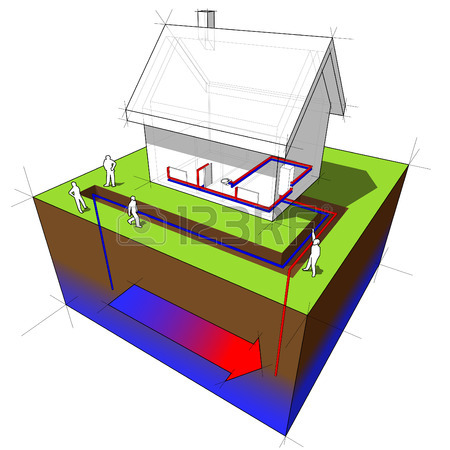
This relatively obscure technology is robust, proven and available now to those willing to understand the simple beauty of these systems.
A geothermal system moves and stores energy rather than producing energy through combustion or resistance. Geothermal systems work by exchanging hot or cold air from the home with the stable stored energy in the ground, rather than by converting chemical energy to heat. This is a renewable energy system that is very efficient and has enough flexibility to fit a variety of applications. Some added benefit in addition efficiency is that geothermal energy creates no pollution to our air or water and other than electricity, they eliminate the need to purchase highly processed petrochemical fuel from less than environmentally conscious producers.
While the air temperature in Pennsylvania can vary from -20 degrees Fahrenheit in the coldest part of winter to over 100 degrees Fahrenheit in the summer, the Earth’s temperature a few feet under the surface is essentially the same in winter and summer. In the winter, the system can heat a home using the Earth’s relatively warm core energy. In the summer, the same system can cool the home with the Earth’s relatively cool mass. Year-round, geothermal systems can produce hot water. Geothermal heat pumps have an efficiency of over 300 to 500 percent (meaning they get a payback of 3 to 5 times the energy used to run the system). This efficiency provides the heating/cooling needs at a cost that is 30 to 70 percent less expensive than conventional energy systems, without combustion, carbon dioxide, methane, water pollution or the waste generated by other energy systems.
Geothermal ground-source heating and cooling systems work during the night when the sun is blocked by clouds and when the wind is not blowing. While electricity costs may vary, geothermal costs don’t fluctuate like natural firewood, gas, coal and heating oil. The ground-source system comes in a variety of configurations to easily fit new home construction or homes with a more conventional, existing duct-based heating and cooling systems.
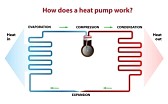
The geothermal system has three main components: connection to the Earth, delivery and distribution system and a geothermal heat pump. The Earth connection allows the system to pull or store heat in the Earth. In heating mode, the system uses the Earth connection to pull a small quantity of heat from the Earth to heat a person’s space. In cooling mode, the system does the reverse and transfers heat from the air back to the Earth.
The distribution system can be a series of vertical connections or loops buried in the ground that transfer and help to distribute the energy. The geothermal heat pump is very efficient energy transfer system that moves the energy from the building to the transfer fluid.
The system does require an electrical source to run the heat pumps and circulation system and it is critical that an existing home have a formal energy audit done prior to installing a system. New construction should use green building and energy efficient insulating systems so the system can be properly sized. The Residential Energy-Efficient Property Credit provides a 30 percent tax credit toward the cost of alternative energy equipment installed on or in a home or business. With these credits, payback on installation is about 10 years+.
Pennsylvania residents could benefit from lower energy costs, elimination of water and air pollution and a significant reduction of the expensive and environmentally destructive infrastructure of fossil fuels by adapting geothermal systems as soon as possible.
To learn more about geothermal energy, visit the Keystone Clean Water Team at CarbonWaters.org or Duane Moyer Well Drilling at MoyerWellDrilling.com.
Article published in the April Addition of Natural Awakenings Magazine
We exist to promote Natural Living in the communities that we serve. Visit HealthyLehighValley.com for online news, events, articles, archives, resources, contests and more information. To sign-up for our newsletter simply reply to this email.
Everything we do began with an idea.
We have offered “Free” Assistance to this effort, but if you are a private well owner that needs assistance we are happy to help.
We realize your time is precious and the world is hectic. CCGG’s volunteers do only what they’re comfortable with. It can be a little or a lot. Get YOUR WATER Tested – Discounted Screening Tests !
For more information, please go to CCGG’s About Page or contact us. Follow us on Twitter
Keystone Clean Water Team is a 501(c)(3) IRS approved nonprofit, volunteer organization and your donation is tax deductible to the extent allowed by law. Unsolicited donations are appreciated (Helps us complete our mission), but we also do local educational workshops and local cellphone/small electronic recycling programs. If you would like to set up a program to help recycle cellphones at an event, business, or other organization. Through our program we can recycle cell phones, iPods, game systems, and small digital cameras. If your interested, please contact us. Our new PSAs.
Help the Organization and Get Your Water Tested or Order the Private Well Owner Guide (proceeds benefit This Organization). Water Science Basics!
Filed under Alternative Energy, consumer products, Energy, engineering applications, Environmental Health, environmental management, Global Warming, Groundwater, Pennsylvania, training, Water · Tagged with April 2015, Geothermal, ground source, heat pump, lehigh valley, natural awakenings magazine, renewable energy
Posted by Brian on April 11, 2015 · Leave a Comment
Participated in a Panel Discussion at the request of Representative Frank Farina – I have not worked on the Invenergy Project and I was requested to be available to answer questions related to geology, hydrogeology, water quality, regulatory process, environmental impacts, stormwater issues, and stream related matters. Prior to attending the event, I visited the site and reviewed the available soils, geologic, and water quality data. I attended the panel discussion with Q/A – a link to a series can be found at the following webportal. I strongly suggest you watch video 6.
During the Panel discussion the following questions were raised
1. How are discharge limits sets? The PADEP set the discharge limits for a facility based on the average and peak discharge flow, existing stream quality, existing stream flow, classification of the stream, and the nature of downgradient users.
2. Have the discharge limits been set? No -the discharge limits have not been set for the stream and the peak flow is 600,000 gpd and a potential average flow is 400,000 gpd.
3. Will the discharge adversely impact the stream? The process the PADEP uses is designed to have no adverse impact on the stream. The PADEP will set discharge limits to prevent and adverse impact on the stream or no impact on the stream depending on the stream quality and classification. For this project, a critical design parameter will be temperature and most likely the design of the outlet structure.
4. What chemicals will be used in the water treatment process? This can not be known until the PADEP sets the limits. The PADEP has a list of allowed chemicals that could be used and are pre-approved. The list is here. Note: This is a list of all the chemicals PADEP has approved for a variety of processes and projects and NOT This Project. This list is not project or site specific.
5. Is it possible that PADEP may set limits that are not attainable? This should not happen, but it may.
6. Limits are set via a NPDES permit process? This process will likely require daily monitoring of the treatment process (incoming water, within process, discharge water) – Certified water testing on a monthly basis – continuous flow monitoring and most likely consist monitoring of pH, temperature, conductivity, and oxygen. The monitoring program will likely include upstream and downstream monitoring of water quality and maybe flow.
7. Water Withdrawal ? Is there enough water ? It appears that the water company has been allocated sufficient water for the area. The allocation process is controlled by the SRBC (Susquehanna River Basin Commission). They regulate the initial water allocation, create a docket, and would have to approve any docket modifications. This may be a docket modification by the SRBC. This would be an excellent time to put in-place in-stream water quality monitoring for the watershed. It was suggested that in-stream monitoring with a web-portal to access daily was being considered.
8. In a drought what happens? SRBC controls allocation via the docket – plant would have to apply to provisions. If this means going off line to meet requirements – this is what would have to happen. The plant could attempt to develop some backup or supplemental sources.
9. Geology for the area ? Any issues ? There does appear to be some historic strip mining and soil mapping suggests some urban dumping. The bedrock is typical of the Llewellyn Formation (coal bearing formation) and the Pottsville Formation (sandstone). The area has no mapped sinkholes, faults, or known geologic hazards.
Video of the Event (20 separate videos – please watch Number 6)
https://www.youtube.com/watch?list=PLKfoQ6aX-A06NVXkLsZ4sbjRNSgCm9ogO&v=1CVr-Gvpenw
News Coverage
http://thetimes-tribune.com/news/business/jessup-power-plant-plan-latest-since-shale-boom-began-1.1532435
http://wnep.com/2015/03/31/action-16-is-invenergy-a-good-neighbor/
In Video 6 – I had to interpret a question because what the person was doing was not asking a question but making a statement that was not true and correct. For the record,
1. I have never sponsored an oil and gas energy event.
2. I have never sponsored an energy event dinner.
3. I did not attend the event in question, but I did get a free invitation to the event because I subscribe to an online newsletter about environmental and oil and gas issues through out the US. This free invitation was to the event only and I would have to pay for lunch. I did register, but I did not attend the event.
4. Rather than attending the event, I helped the DCNR with a program that was scheduled for the Tues before and Thursday after on environmental issues with natural gas development, but because a tour for a drilling site could not be set-up we did a tour and water testing of a salt water spring in Susquehanna County, PA.
5. As a fallout of the tour- we are in the process of raising funds to help purchase 3-Phosphate testing meters for the DCNR Program – estimated cost $ 2000.00. Send donations via this portal. The next $ 2K raised will go to buying the water quality meters.
Added Link to Article I found from Charlie Charlesworth on the event.
Everything we do began with an idea.
We have offered “Free” Assistance to this effort, but if you are a private well owner that needs assistance we are happy to help.
We realize your time is precious and the world is hectic. CCGG’s volunteers do only what they’re comfortable with. It can be a little or a lot. Get YOUR WATER Tested – Discounted Screening Tests !
For more information, please go to CCGG’s About Page or contact us. Follow us on Twitter
Keystone Clean Water Team is a 501(c)(3) IRS approved nonprofit, volunteer organization and your donation is tax deductible to the extent allowed by law. Unsolicited donations are appreciated (Helps us complete our mission), but we also do local educational workshops and local cellphone/small electronic recycling programs. If you would like to set up a program to help recycle cellphones at an event, business, or other organization. Through our program we can recycle cell phones, iPods, game systems, and small digital cameras. If your interested, please contact us. Our new PSAs.
Help the Organization and Get Your Water Tested or Order the Private Well Owner Guide (proceeds benefit This Organization). Water Science Basics!
Filed under Air Quality, Alternative Energy, Clean Water Act, Environmental Health, environmental management, Global Warming, Groundwater, marcellus shale, natural gas power plant, Real Estate, Unconventional Gas, Water Testing · Tagged with Charlie Charlesworth, Citizens for a Healthy Jessup, clean energy, in Archbald/Jessup, Invenenergy, invenergy, Jessup, Lackawanna County, Natural-gas fired plant
Posted by Brian on April 7, 2015 · Leave a Comment
To the average observer, algae may look like a slimy mess. But in the green-tech world, they’re versatile workhorses that can be converted to biofuels, air purifiers and electricity.
Now a Michigan startup is harnessing it as a feed additive to address the pervasive problem of unnecessary antibiotics use on healthy animals in factory farms—a problem that’s led to the rise of antibiotic-resistant bacteria (also known as superbugs) that are a threat to global public health.
Algal Scientific is extracting beta glucan—a chain of simple sugars—from algae for use as an immune system support and alternative to antibiotics. CEO Geoff Horst says that the substance works by supporting the immune system via stimulating the growth of white blood cells.
“Most [beta glucan] on the market now is extracted from yeast cell walls, and it’s very expensive as they end up paying for refined beta glucan,” he said.
Dubbed Algamune, Horst says that his product is more potent—as well as cheaper—than the versions derived from yeast, since it’s more bioavailable.
Algamune—which is now being produced on a commercial scale in the U.S. and used by shrimp growers in Ecuador and Vietnam, as well as by chicken producers that Horst declined to name—got approved for use in the U.S. last year, and a few months ago in the EU after clearing regulatory requirements. The decisions capped a three-year process of R&D and testing the product in chickens, pigs, fish and shrimp at Texas A&M University and commercial settings.
Just last week, the company announced it had received $7 million in a second round of venture capital funding, which Horst says will now allow Algal Scientific to start working on a beta glucan feed additive for cows, aquaculture and pet food.
The support is a timely shot in the arm at a time when the world is standing on what journalist Maryn McKenna recently described as “the threshold of the post-antibiotic era” during her TED talk in Vancouver a few weeks ago.
Currently, antibiotic resistance is responsible for the deaths of 700,000 people a year worldwide, and by 2050 could claim more lives than cancer at 10 million deaths annually, according to the British-funded Review on Antimicrobial Resistance.
At TED, McKenna told the story of her great uncle Joe McKenna, a New York City firefighter who died from a simple infection after getting hit by a fire hose—a few years before penicillin was discovered by Sir Alexander Fleming in 1928.
“Most people died back then the way my uncle died because they didn’t live long enough to develop heart disease,” she said. “They died most of the time from infection. All of that changed when antibiotics arrived.”
Every time we use an antibiotic, we give bacteria billions of chances to crack the codes of the defenses we’ve constructed, she said.
Eighty percent of antibiotics used in the U.S.—or nearly 30 million pounds—are mostly dispensed at factory farms as a way to prop up animals’ immune system. This contributes to the spread in antibiotic-resistant bacteria, which gets into the groundwater via the farms’ runoff. Overuse in humans is also part of the problem: According to the Centers for Disease Control, up to half of antibiotic prescriptions are unnecessary.
If the superbugs win, and nothing is done to address the problem now, we would return to that era when skin infections would cause fear, McKenna said.
“If we lost antibiotics, we’d lose cancer patients, AIDS, premature babies and transplant recipients as well as stents for stroke, pumps for diabetes and new hips and knees,” she said. “This is asymmetric warfare, but we can change the outcome.”
Read the Full Original Article
Comment – About 10 years ago – I said “One day we may be making some of our waters green – to increase productivity and harvest the benefits of algae”.
Learn More About Natural Gas Energy Environment Development, Fracking, Fracking Terms, and Sustainability
Everything we do began with an idea.
We have offered “Free” Assistance to this effort, but if you are a private well owner that needs assistance we are happy to help.
We realize your time is precious and the world is hectic. CCGG’s volunteers do only what they’re comfortable with. It can be a little or a lot. Get YOUR WATER Tested – Discounted Screening Tests !
For more information, please go to CCGG’s About Page or contact us. Follow us on Twitter
Keystone Clean Water Team is a 501(c)(3) IRS approved nonprofit, volunteer organization and your donation is tax deductible to the extent allowed by law. Unsolicited donations are appreciated (Helps us complete our mission), but we also do local educational workshops and local cellphone/small electronic recycling programs. If you would like to set up a program to help recycle cellphones at an event, business, or other organization. Through our program we can recycle cell phones, iPods, game systems, and small digital cameras. If your interested, please contact us. Our new PSAs.
Help the Organization and Get Your Water Tested or Order the Private Well Owner Guide (proceeds benefit This Organization). Water Science Basics!
Filed under algamune, Biosolids, engineering applications, Uncategorized · Tagged with algae, algamune, antibiotic, biofuels, Energy, glucan, Soylent green, Sustainability
Posted by Brian on April 3, 2015 · 1 Comment
Natural gas production from the Marcellus shale formation in the increased to 14.4 billion cubic feet per day (Bcf/d) in January 2015, accounting for more than 36% of shale gas production and more than 18% of total dry natural gas production in the United States, according to EIA’s Natural Gas Weekly Update. Recent updates to EIA’s maps and geologic information for the Marcellus shale play help to characterize the formation’s structure, thickness, and extent. EIA uses well data to construct maps showing the formation extent and structure of the productive and prospectively productive regions of the Marcellus. Structure and thickness maps are key elements in resource estimation and in defining the areas where hydrocarbon extraction is economical. Maps showing the top and bottom of the formation as 3-D surfaces can be used for a rough estimation of subsurface volumes, as well as detection of regional structural and tectonic features such as major faults, folds, and thrusts. Post provided for educational purposes.
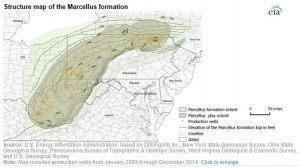
Depth to the Formation
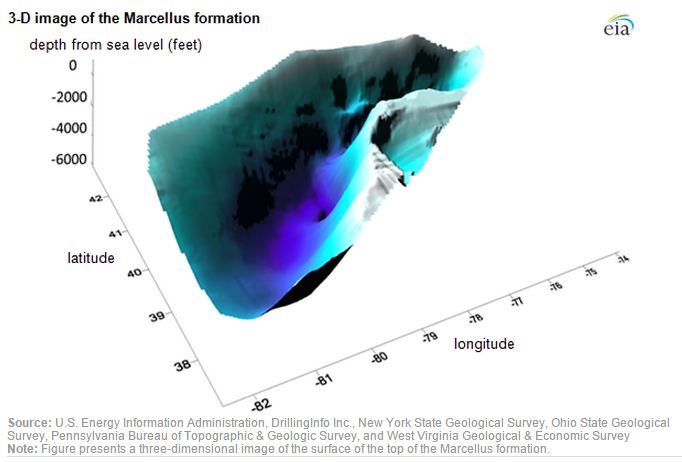
3D Diagram of the Basin
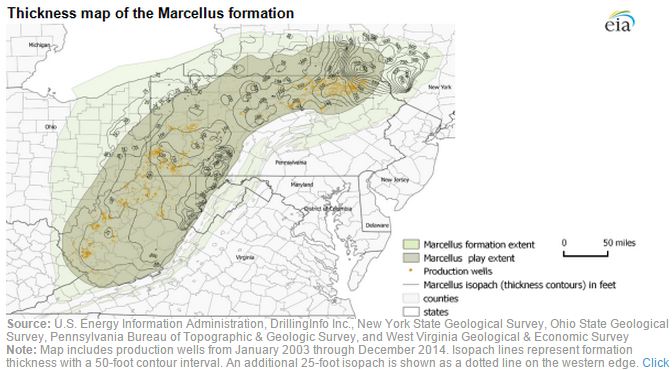
Thickness of the Marcellus Shale
Sources:
http://www.oilvoice.com/n/Updated-geologic-maps-provide-greater-detail-for-Marcellus-formation/38a70524ca6b.aspx
Principal Contributors: Olga Popova, Evan Frye, Elizabeth Panarelli (Oil Voice) 4/1/15
“The Ben Franklin Shale Gas Innovation and Commercialization Center (www.sgicc.org) is designed to harness innovation and new technologies to maximize the economic return to Pennsylvania’s citizens from the Marcellus and Utica shale formations. The Center’s goal is to increase sustainable employment and wealth creation in Pennsylvania that has the potential to outlast the initial exploration, production and transportation of natural gas from the formations. The Center will also identify, support and commercialize technologies and early-stage businesses that enhance responsible stewardship of the environment while properly utilizing this transformative energy asset.”
Learn More About Natural Gas Development, Fracking, Fracking Terms, and Sustainability
Everything we do began with an idea.
We have offered “Free” Assistance to this effort, but if you are a private well owner that needs assistance we are happy to help.
We realize your time is precious and the world is hectic. KCWT’s volunteers do only what they’re comfortable with. It can be a little or a lot. Get YOUR WATER Tested – Discounted Screening Tests !
For more information, please go to KCWT’s About Page or contact us. Follow us on Twitter
Keystone Clean Water Team is a 501(c)(3) IRS approved nonprofit, volunteer organization and your donation is tax deductible to the extent allowed by law. Unsolicited donations are appreciated (Helps us complete our mission), but we also do local educational workshops and local cellphone/small electronic recycling programs. If you would like to set up a program to help recycle cellphones at an event, business, or other organization. Through our program we can recycle cell phones, iPods, game systems, and small digital cameras. If your interested, please contact us. Our new PSAs.
Help the Organization and Get Your Water Tested or Order the Private Well Owner Guide (proceeds benefit This Organization). Water Science Basics!
Filed under Groundwater, marcellus shale, Methane Gas Migration, New York, Pennsylvania, Unconventional Gas, Water Testing, Well water testing · Tagged with extent, fold faults, formation thickness, fractures, marcellus shale, natural gas development, New York, Pennsylvania, shale gas, three dimension structure
« Previous Page — Next Page »





